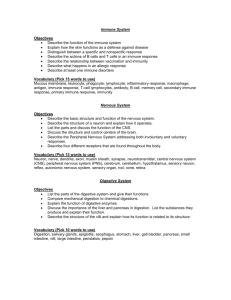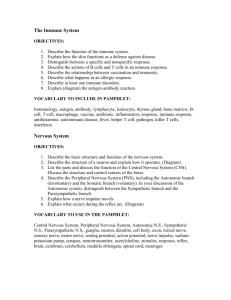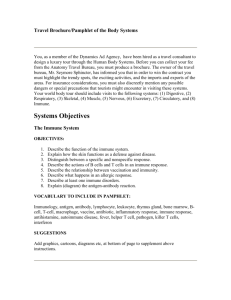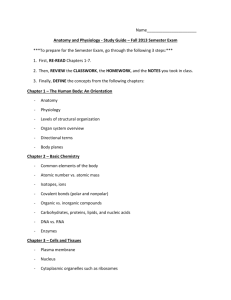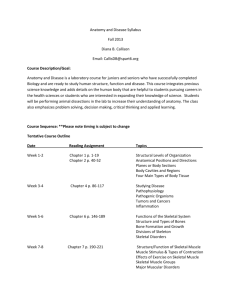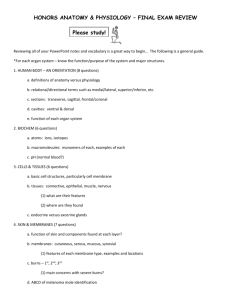Human Body System Final Project
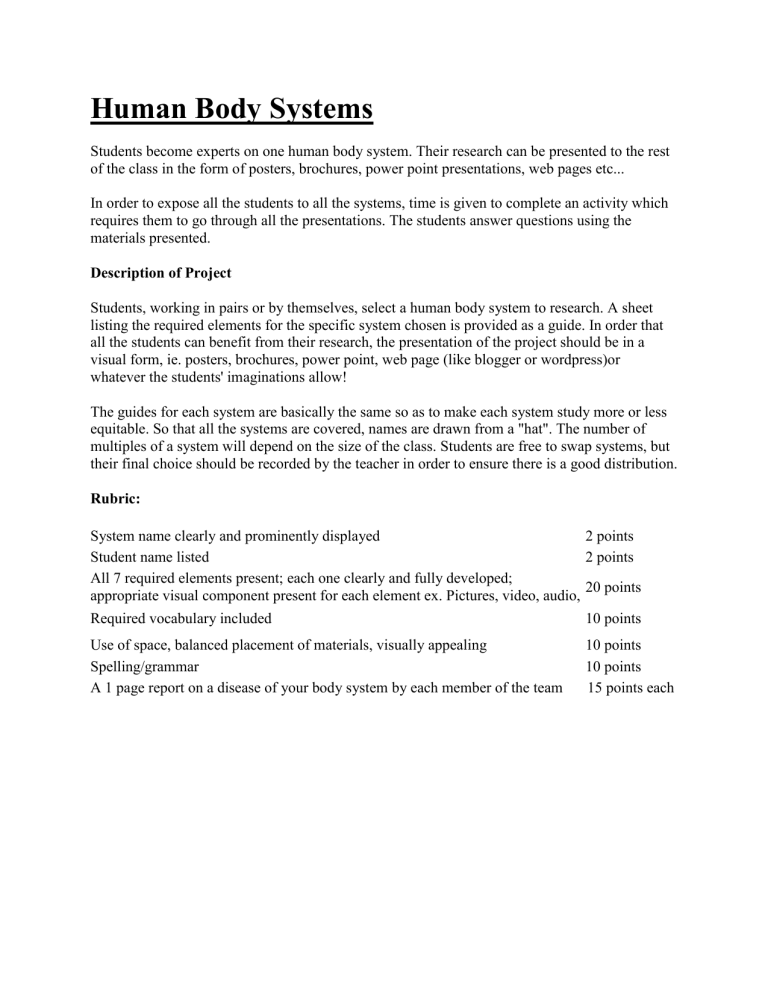
Human Body Systems
Students become experts on one human body system. Their research can be presented to the rest of the class in the form of posters, brochures, power point presentations, web pages etc...
In order to expose all the students to all the systems, time is given to complete an activity which requires them to go through all the presentations. The students answer questions using the materials presented.
Description of Project
Students, working in pairs or by themselves, select a human body system to research. A sheet listing the required elements for the specific system chosen is provided as a guide. In order that all the students can benefit from their research, the presentation of the project should be in a visual form, ie. posters, brochures, power point, web page (like blogger or wordpress)or whatever the students' imaginations allow!
The guides for each system are basically the same so as to make each system study more or less equitable. So that all the systems are covered, names are drawn from a "hat". The number of multiples of a system will depend on the size of the class. Students are free to swap systems, but their final choice should be recorded by the teacher in order to ensure there is a good distribution.
Rubric:
System name clearly and prominently displayed
Student name listed
2 points
2 points
All 7 required elements present; each one clearly and fully developed; appropriate visual component present for each element ex. Pictures, video, audio,
20 points
Required vocabulary included 10 points
Use of space, balanced placement of materials, visually appealing 10 points
Spelling/grammar 10 points
A 1 page report on a disease of your body system by each member of the team 15 points each
Skeletal System
Required Elements
1. State the functions of the skeletal system.
2. Describe the chemical composition of bone.
3. Describe the formation, growth and repair of bone.
4. Explain the role of cartilage in the skeletal system from the point of view of stages in the life of an individual ie. Embryos through to adults.
5. Identify the number and the major bones (20 in all) in the human skeleton.
6. Describe the different kinds of joints: ball and socket, hinge, pivot, gliding and saddle. Use examples.
7. Each team member needs to write a report on a (different disorders) disorder of the system.
Vocabulary to be included: appendicular skeleton, axial skeleton, arthritis, ligaments, tendons, periosteum, Haversian canals, marrow, ossification, joints, synovial fluid, cartilage, osteocytes, osteoclasts, osetoblasts
Respiratory System
Required Elements
1. Identify and describe the structure and function of the parts of the respiratory system.
2. Explain the mechanics of breathing. Include the role of intercostal muscles, diaphragm and air pressure.
3. Explain how breathing rate is controlled. Include the role of carbon dioxide and the medulla oblongata (brain area).
4. Discuss the relationship between the alveoli and capillaries.
5. Discuss the function and importance of the ciliated epithelium lining the respiratory passages.
Include the effects of smoking on this tissue.
6. Describe the workings of the larynx.
7. Each team member needs to write a report on a (different disorders) disorder of the system.
Vocabulary to be included: alveoli, gas exchange, epiglottis, trachea, bronchi, bronchiole, larynx, lung, oxygen, carbon dioxide, pharynx, respiration, vital capacity, inhalation, exhalation, cilia, respiratory control center, diaphragm, intercostal muscles, nasal passages,
Muscular System
Required Elements
1. Compare the structure and function of the three types of muscle tissue at the cellular level. Use examples.
2. Draw, color and label 15 of the bodies major muscles.
3. Explain muscle fatigue.
4. Describe the effect of exercise on skeletal muscle.
5. Explain the interaction of flexors and extensors. Refer to the role of tendons, ligaments and bones. Give at least 3 examples of flexor-extensors pairs and the movements they control.
6. Discuss and explain how some muscles get tired more easily than others.
7. Each team member needs to write a report on a (different disorders) disorder of the system.
Vocabulary to be included:
muscle fiber, myofibril, , sarcomere, actin, myosin, skeletal muscle, cardiac muscle, smooth muscle, tendon, ligament, flexor, extensor, fatigue, contraction, relaxation
Circulatory System
Required Elements
1. List the functions of the human circulatory system.
2. Describe the structure and role of each type of blood vessel: artery, vein and capillary.
3. Describe the structure and functioning of the heart and the flow of blood through the heart.
4. Describe the characteristics and roles of the various blood components: platelets, white blood cells, red blood cells and plasma.
5. Explain the origin and development of each of the various blood cells. Refer specifically to the bone marrow and the spleen.
6. Describe what blood pressure is and how it is measured.
7. Each team member needs to write a report on a (different disorders) disorder of the system.
Vocabulary to be included: aorta, artery, vein, capillary, arteriole, inferior and superior vena cava, atrium, ventricle, , hemoglobin, platelet, diastole, systole, plasma, pacemaker, lymph, oxygen
Nervous System
Required Elements
1. Describe the role of the nervous system.
2. Describe the structure and functioning of the basic unit of the nervous system, the neuron.
3. Explain how nerve impulses travel and what occurs during a reflex arc.
4. List the parts and discuss the function of the central nervous system.
5. Map out the major areas and control centers of the brain and discuss their roles.
6. Describe the two branches of the peripheral nervous system: the autonomic branch and the somatic branch.
7. Each team member needs to write a report on a (different disorders) disorder of the system.
Vocabulary to be included. central nervous system, peripheral nervous system, autonomic nervous system, somatic nervous system, sympathetic nervous system, parasympathetic nervous system, neuron, dendrite, cell body, axon, nerve impulse, synapse, neurotransmitter, stimulus, response, reflex arc, brain, cerebrum, cerebellum, medulla oblongata, spinal cord
Immune System
Required Elements
1. Discuss the role of the immune system.
2. Explain how the skin functions as the first line of defense against disease.
3. Discuss the role of B and T cells in an immune response.
4. Discuss the relationship between vaccination and immunity, between natural and acquired immunity.
5. Describe what occurs in an allergic reaction and in a transplant rejection reaction.
6. Describe how the lymph nodes play a role in the immune system.
7. Each team member needs to write a report on a (different disorders) disorder of the system.
Vocabulary to be included: immunology, antigen, antibody, lymphocyte, thymus gland, bone marrow, B-cell, T-cell, macrophage, vaccine, inflammatory response, immune response, antihistamine, autoimmune disease, fever, pathogen
Excretory System
Required Elements
1. Describe and discuss the importance of excretion.
2. Describe the role of the skin, kidneys, lungs and liver in the excretory process.
3. Describe the structure of the kidneys and how the associative structures (the ureters, the urethra and bladder) work together to excrete urine.
4. Describe the structure and functioning of the basic unit of the kidney, the nephron. Include the processes of filtration and reabsorption.
5. Discuss the role of the circulatory system in the work of the kidneys.
6. Describe dialysis treatment.
7. Each team member needs to write a report on a (different disorders) disorder of the system.
Vocabulary to be included: excretion, kidney, nephron, Bowman's capsule, filtration, reabsorption, ureter, urethra, urine, bladder, aorta, renal vein, renal artery, adrenal glands, metabolic wastes, sweat glands, dialysis, carbon dioxide, ammonia, renal cortex, renal medulla
Digestive System
Required Elements
1. Illustrate the parts of the digestive system.
2. Compare mechanical digestion to chemical digestion.
3. Discuss the chemical digestion of carbohydrates, proteins and fats with respect to enzymes involved, the products of digestion and sites of digestion.
4. Discuss the importance of the liver and pancreas in digestion.
5. Discuss the absorption of nutrients into the blood. Explain how the structure of the villi accommodates this process.
6. Discuss the role of sphincter muscles and peristalsis.
7. Each team member needs to write a report on a (different disorders) disorder of the system.
Vocabulary to be included: digestion, salivary glands, epiglottis, stomach, pyloric sphincter valve, duodenum, liver, gall bladder, pancreas, small intestine, large intestine, villi, mesentery, rectum, mucous, feces, peristalsis, hydrochloric acid, bile, E. coli, pH
